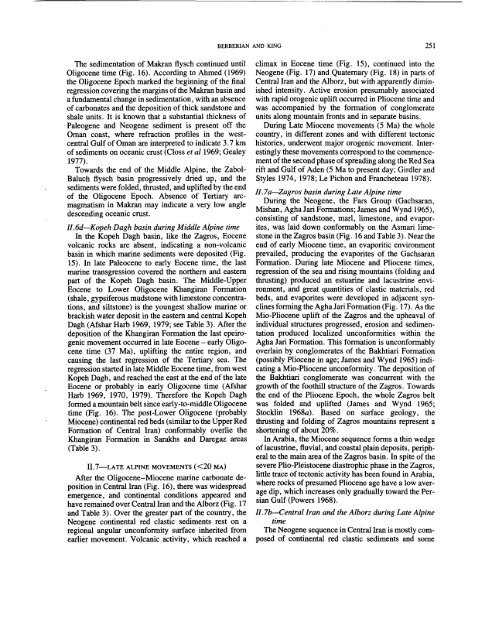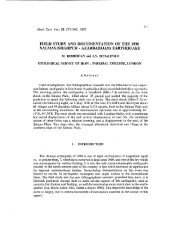PDF COPY - Manuel berberian
PDF COPY - Manuel berberian
PDF COPY - Manuel berberian
Create successful ePaper yourself
Turn your PDF publications into a flip-book with our unique Google optimized e-Paper software.
The sedimentation of Makran flysch continued until<br />
Oligocene time (Fig. 16). According to Ahmed (1969)<br />
the Oligocene Epoch marked the beginning of the final<br />
regression covering the margins of the Makran basin and<br />
a fundamental change in sedimentation, with an absence<br />
of carbonates and the deposition of thick sandstone and<br />
shale units. It is known that a substantial thickness of<br />
Paleogene and Neogene sediment is present off the<br />
Oman coast, where refraction profiles in the westcentral<br />
Gulf of Oman are interpreted to indicate 3.7 km<br />
of sediments on oceanic crust (Closs et al 1969; Gealey<br />
1977).<br />
Towards the end of the Middle Alpine, the Zabol-<br />
Baluch flysch basin progressively dried up, and the<br />
sediments were folded, thrusted, and uplifted by the end<br />
of the Oligocene Epoch. Absence of Tertiary arcmagmatism<br />
in Makran may indicate a very low angle<br />
descending oceanic crust.<br />
H.6d--Kopeh Dagh basin during Middle Alpine time<br />
In the Kopeh Dagh basin, like the Zagros, Eocene<br />
volcanic rocks are absent, indicating a non-volcanic<br />
basin in which marine sediments were deposited (Fig.<br />
15). In late Paleocene to early Eocene time, the last<br />
marine transgression covered the northern and eastern<br />
part of the Kopeh Dagh basin. The Middle-Upper<br />
Eocene to Lower Oligocene Khangiran Formation<br />
(shale, gypsiferous mudstone with limestone concentrations,<br />
and siltstone) is the youngest shallow marine or<br />
brackish water deposit in the eastern and central Kopeh<br />
Dagh (Afshar Harb 1969, 1979; see Table 3). After the<br />
deposition of the Khangiran Formation the last epeirogenic<br />
movement occurred in late Eocene - early Oligocene<br />
time (37 Ma), uplifting the entire region, and<br />
causing the last regression of the Tertiary sea. The<br />
regression started in late Middle Eocene time, from west<br />
Kopeh Dagh, and reached the east at the end of the late<br />
Eocene or probably in early Oligocene time (Afshar<br />
Harb 1969, 1970, 1979). Therefore the Kopeh Dagh<br />
formed a mountain belt since early-to-middle Oligocene<br />
time (Fig. 16). The post-Lower Oligocene (probably<br />
Miocene) continental red beds (similar to the Upper Red<br />
Formation of Central Iran) conformably overlie the<br />
Khangiran Formation in Sarakhs and Daregaz areas<br />
(Table 3).<br />
II.7--LATE ALPINE MOVEMENTS (







